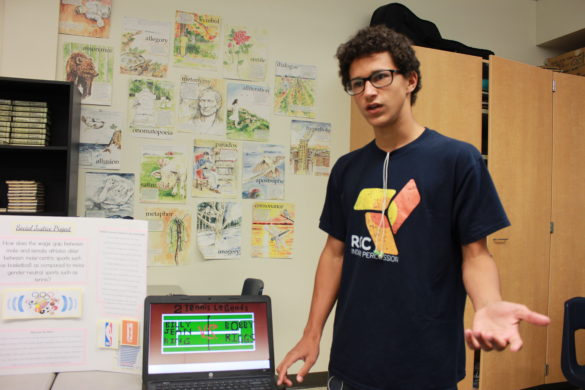
Henry Caprini (’19) presents his topic of equal pay in sports through a comic. Photo by Ivy Duong.by Ivy Duong, Staff Photographer, and Bethany Pham, Staff Writer
Fountain Valley High School English teachers Elise Hamilton and Elizabeth Taireh are introducing a new type of undertaking for their Honors English 2 classes this year: the social justice project.
The social justice project is meant to correlate to the English students’ reading of Holocaust survivor Elie Wiesel’s memoir Night, delineating Wiesel’s experiences in the notorious Nazi death camp Auschwitz. Focused on social injustice and crimes against humanity, the memoir gave both teachers an opportunity to craft a new, experimental project.
“I think that Night definitely wins itself to a call for action when it comes to social injustices,” said Hamilton, “so at the end of Elie Wiesel’s book Night, he talks about what it means to be a witness at a social injustice and I thought it would be a really great way to honor the legacy of a Holocaust survivor who turned his pain into passion to become a huge activist for human rights all over the world.”
However, the project’s focus still turns around full circle to the students. Hamilton and Taireh took note of the countless social issues that are now making such a buzz among today’s youth. With a generation of activists growing, the plethora of publicized problems evoke an array of opinions from all people, and some of those opinions have no foundation or basis in fact. This opens up the more academic aspect of the project.
“The ultimate goal of this project is gathering information and knowledge about different social justice topics in the community and around the world. I want them [the students] to learn that the social justice issues aren’t as black and white as we think they are and much more complicated than we think. Therefore, dealing with these injustices and issues requires a lot more than passion. It requires in depth knowledge on the specific social injustice. I explain to the students that before you can act on any social injustices you see, you have to educate yourself on it and you have to know about it,” said Hamilton.
Working with Taireh, they decided to approach the project differently. Rather than making the entire project informational, they’ve allowed students to creatively present their information. Students have been working on the project, creating posters, pamphlets, videos, and much more.
“I’m definitely taking a more creative approach for this project. I’m also allowing students to choose topics they want to choose,” said Hamilton.
Hamilton and Taireh have seen students taking a real interest to the new social justice projects. They stated the project is designed to make personal connections to students and highlight their concerns for the world.
“From what I’ve seen, students have been pretty excited working on these [projects],” Hamilton said. “I think what they’re most excited about is the openness and creativity. They get to show their information in a lot of different ways that are really open and I think that choosing their own social issues, they’re connecting with their project a lot more. I really like [the project] and, based on the students’ reaction, it seems to be really positive. I never do the exact same project every year in the same way, so I’ll look at the project and see what works and learn and grow.”





